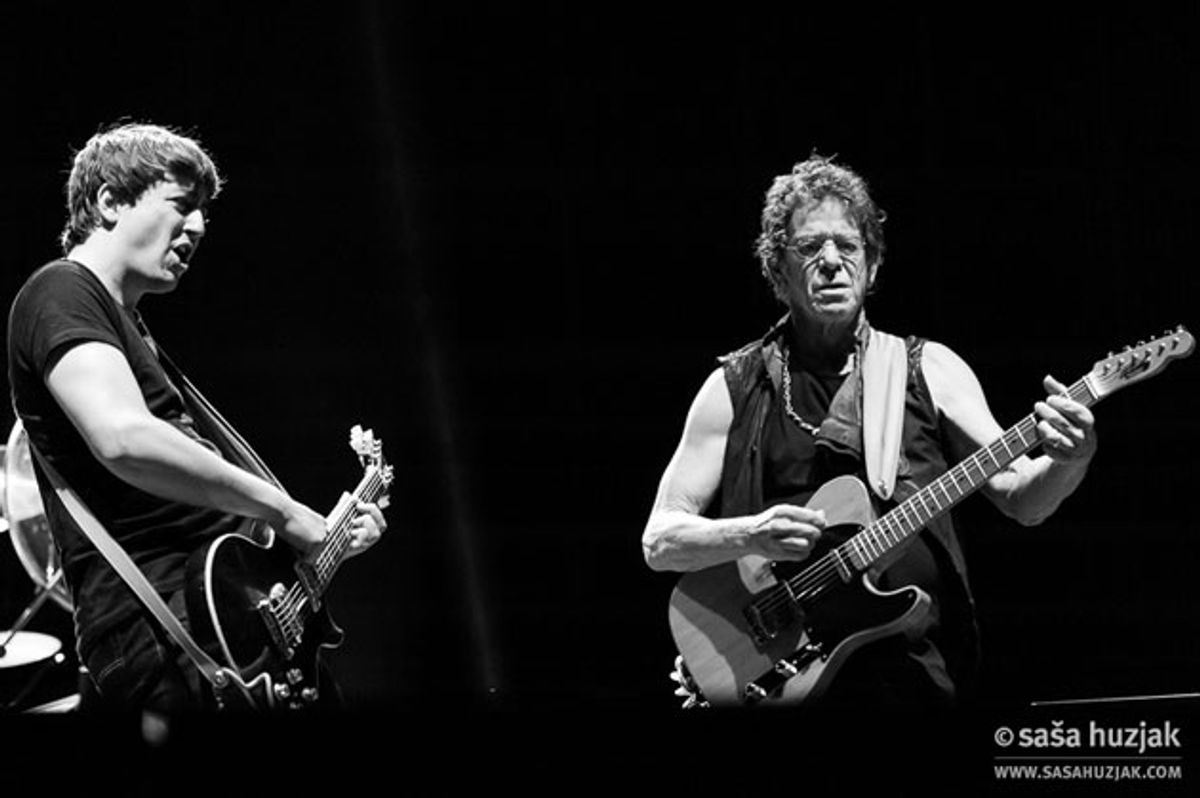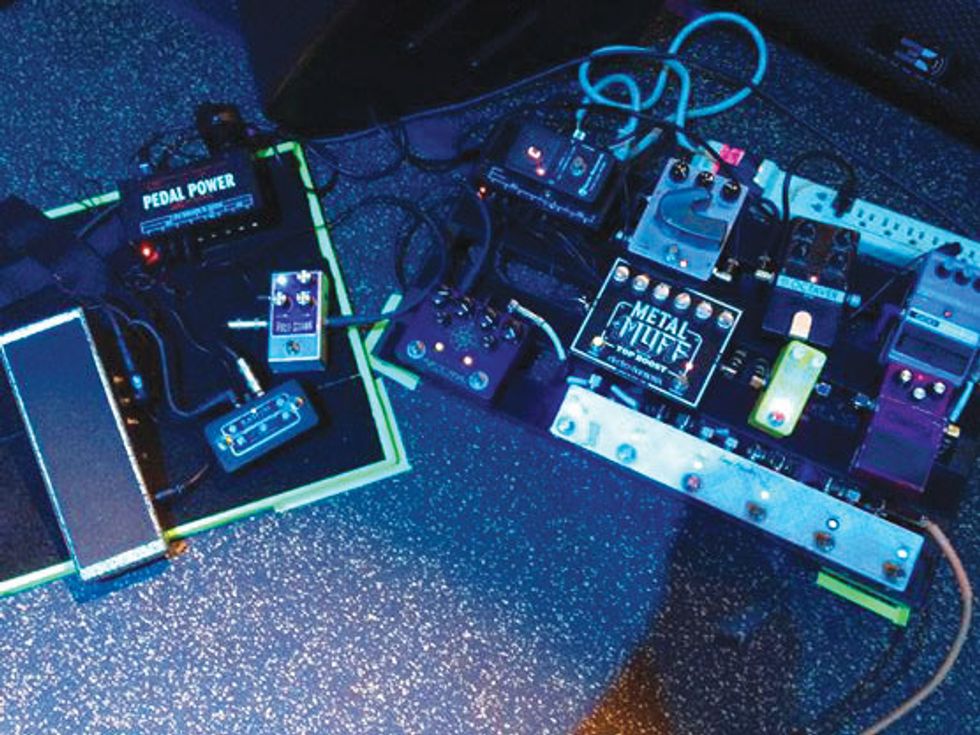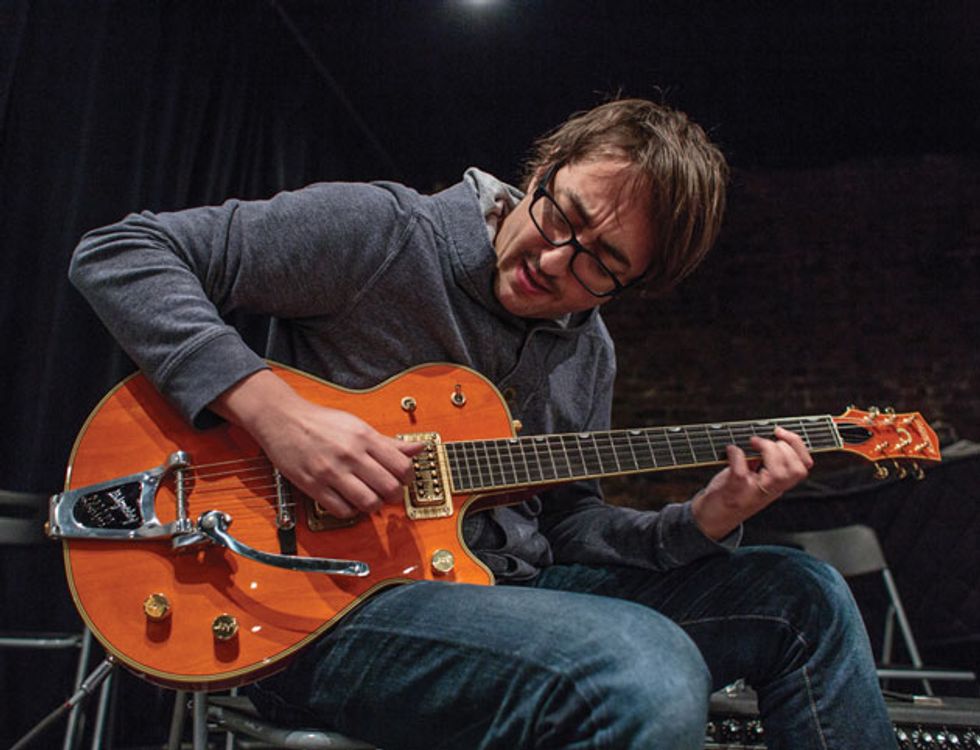From Lou Reed’s last band to Diana Krall’s quartet, this NYC guitarist always pushes boundaries—and himself.
Few guitarists cover as much territory, both stylistically and literally, as Aram Bajakian. Not long ago the Queens-based guitarist found himself copping James Hetfield riffs for the late Lou Reed, playing in Freddie Green mode with singer/pianist Diana Krall, and improvising on works by maverick composer John Zorn—all in the same week.
Bajakian is part of New York’s Downtown scene, a group of improvising performers and composers such as Zorn and guitarists like Marc Ribot and Bill Frisell that emerged in the 1970s. Their music, which sometimes receives such oversimplified labels of “experimental” and “avant-garde,” is in fact quite catholic, drawing inspiration from many sources, both high and low.
Bajakian has similarly wide-ranging tastes. In his formative years he was equally curious about Javanese gamelan music, Ewe drumming from Ghana, Prokofiev piano concertos, the introspective rock of My Bloody Valentine, and the blues stylings of Clarence “Gatemouth” Brown.
The blues influence is especially apparent on there were flowers also in hell, a trio outing with bassist Shahzad Ismaily and drummer Jerome Jennings. The record reveals Bajakian as a sardonic composer, a masterly improviser, and a purveyor of excellent tones who finds new wrinkles in one of the most traditional musical forms.
Aram Bajakian's Gear
Guitars
1937 Gibson L-50
Rick Kelly S-style with Don Mare Super Sports
Rick Kelly T-style with Don Mare Super Sports
Amps
1964 Fender Deluxe Reverb
1967 Fender Vibro Champ
Effects
Analog Man King of Tone
Blackstone Appliances Mosfet Overdrive 2S
Boss DM-2
DOD FX90
Ramble FX Twin Bender
Tortenmann Tremolo
Tortenmann Fuzz
Union Tube & Transistor Buzz Bomb
a
WrightSounds Fuzz-Stang
Strings and Picks
D’Addario EXL115 strings (.011-.049)
What did you set out to do with there were flowers also in hell?
I wanted a record that wasn’t just about having great tone and amazing songs and solos. I wanted a record that really expressed my day-to-day life in Queens. “The Kids Don’t Want to Sleep” is a reflection of what it’s like when you’re trying to get your two-month-old to sleep at three in the morning, and there are kids outside your apartment screaming. All the songs on the record reflect some personal aspect of my life.
What was it like to work with Shahzad Ismaily and Jerome Jennings?
I wanted to work with Shahzad because I’d never played with him, and I felt he could teach me some things. He’s a masterful bass player who always plays really hip-sounding things. Plus he’s such a sweet guy, and that energy comes through in his playing. Jerome is also a sweetheart and plays his drums as if his life depended on it, which is similar to the approach I take. He also reminds me of Mitch Mitchell.
What was your compositional process like?
It was mostly organic. I’d come up with a riff, often referencing the blues, and then develop it on my own or with the band. “Texas Cannonball” is based on a Freddie King riff. “Orbisonian” sounds nothing like Roy Orbison, but is based on a riff I borrowed from one of his songs. “Loutone” just has this really catchy melody. Same with “Rent Party.” I’m really into writing catchy melodies, and then combining them with messed-up sounds. This is probably because I love the Beatles. I wrote “Medicaid Lullaby” just sitting on my couch in five minutes. I remember joking with my wife that it came out so easily, probably because I had been singing so many lullabies to our daughter at that point. But it’s also one of the most powerful compositions on the record. We got into the space and created this really moving piece. Some great work comes from slaving at it, and other pieces come easily. You just have to be open and flexible, and know how and what to listen for when it’s coming. It’s important not to get hung up on the process.
How did you record??
I only recorded for one day for two reasons: First, I couldn’t afford to hire a band and a studio for longer than that! But I also like to keep things alive and fresh. So much music now is calculated and perfect, but that’s not my aesthetic. If you get into it for days and start doing multiple takes, it just sucks the life out. On the other hand, all those great Stax tracks were recorded in a few hours, and they kill, so I’m trying to keep with that aesthetic. I tried to keep things simple. For example, there were just three mikes on the drums and a mike on each amp, and that was it.
You make interesting use of repetition.
Yes—on “Rent Party,” the way Shahzad uses the looper pedal during that solo is insane. These are not pretty-sounding loops, like you hear a lot of people do. He takes it out! On “For Julia,” I just repeat that line again and again. It’s a real minimalist approach, but it creates a beautiful place and tension.
"For the Lou Reed/Metallica songs, I went through a dozen or so high-end boutique pedals trying to find the right sound, but the Metal Muff was what really got it, especially when blended with the other guitar player's (Tony Diodore) Green Big Muff,” says Aram Bajakian of this pedalboard he used while supporting Lou Reed. “They sounded huge together and provided a great base for Lou to play some of his amazing feedback solos over." Photo by Aram Bajakian
Were there happy accidents while recording?
One thing that I love happens on “Sweet Blue Eyes.” Originally I did one take of the solo, but it was bugging me, so later in the day I took one more pass at it. Afterwards Shahzad said, “Why don’t we listen to both takes at the same time?” It sounded killer, and then at the end there’s a point where the two parts play this great line together as if it was planned out. It’s really amazing when things like that happen.
Talk about the guitars you used.
I used my Rick Kelly Tele and Strat. Rick has a shop [in New York’s West Village] on Carmine Street and has made instruments for Lou Reed, Bob Dylan, Bill Frisell, Marc Ribot, and a bunch of other well-known players. His guitars are really great and totally handmade. My Tele is made of old pine that came from the beams of Jim Jarmusch’s New York loft when he had it remodeled. It has a massive [Douglas] fir neck with no truss rod that’s just insanely great. The fir came from the Chelsea Hotel, so it’s really a New York guitar. The whole thing vibrates and is just beautiful. I have Don Mare Super Sports in both my Strat and my Tele. Those pickups sound so good.
"I also used a 1937 Gibson L-50 with a 1940s DeArmond pickup. It too sounds amazing. I picked it up for $1,000 on Craigslist a few years back—there are still some deals out there in the insane vintage market. I used the L-50 on “Medicaid Lullaby,” “Japanese Love Ballad,” and “For Julia.” I had a [Neumann] U 67 condenser on the acoustic guitar, and at the same time intentionally bled the amped sound from an adjacent room into the mike. It’s a really beautiful effect."
What about amps?
I split my signal between my ’64 blackface [Fender] Deluxe Reverb and a cranked ’67 blackface Vibro Champ. Through each one I had a signal chain consisting of delay, distortion, fuzz, and a “crazy fuzz.” That way I could do one take, but have a bunch of different sounds to work with. A lot of stuff that sounds like layered guitars is really just one or two separate takes, blended in different combinations.
Aram Bajakian is a man of many guitars. Here he picks on a Bigsby-equipped Gretsch during an art-house show with jazz-fusion group Abraxas. Photo by Scott Friedlander
How does this differ from your live setup?
When I gig in New York, I just bring a guitar or two, along with my Analog Man King of Tone pedal, Boss DM-2 delay, and Turbo Tuner, and plug into a house amp. It’s easy to carry all this on the subway!
Tell us about playing with Lou Reed on his final two tours.
I’ve been really fortunate to work with a lot of incredibly talented people, world-class musicians. But Lou is the only person I’ve met whom I’d really call a genius. He wrote all these songs that were just on another level. They’re so simple—some have just two or three chords. But there’s a spirit and energy behind them, a realness that comes from life experiences, and that’s what makes them great.
And in truth, it was really difficult to play some of those songs, like “Sad Song” or “Junior Dad,” night after night. Lou also had an incredible attention to detail. For the last show we did together, at Royal Festival Hall in London, we spent hours on our soundcheck working on only one song, getting all of the components just right. At the same time, he always kept things spontaneous. At one show he pointed at me out of the blue to do a solo, and there was this great energy in that moment. The next night he tried to do the same thing, but he knew it was a different energy, so we didn’t end up doing the solo. He was very attuned to that—you always had to be aware and “on.”
What was it like to shift gears and play with Diana Krall?
It was pretty drastic. In a short time I went from playing Metallica riffs and Velvet Underground songs with Lou to playing 1920s standards with Diana Krall to playing John Zorn’s Masada pieces with Abraxas at the Jazz in Marciac Festival, and then back to playing with Lou a few days later. That was pretty insane. But playing with Diana was a real fun time. She works in an old-school way, like Nat King Cole. It’s not fancy or flashy, but really about nuance and phrasing. Her chord voicings and feel are just so elegant—very deep. It was a real lesson getting to play with her and the rhythm section of Dennis Crouch on bass and Jay Bellerose on drums every night.
YouTube It
Aram Bajakian matches wits with Lou Reed on the classic “Waves of Fear.”
Bajakian works in a rootsier mode with Diana Krall. Check out the hot solo at 2:51.
Bajakian plays pieces from John Zorn’s Masada songbook in this cool, concert-length video.
Have you consciously developed a personal approach to guitar, or has it come about naturally by playing so many different types of music?
In a lot of ways I’ve always sounded like I sound. In fact, I heard something from the band that I had in seventh grade, and my solo sounds a lot like I do now. But I’m always trying to push myself in terms of what I listen to, and I’ve found that all great artists do that. By listening to all this different music, it somehow filters into what I play. If you don’t like hip-hop, dig into hip-hop. If you don’t like metal, dig into some metal. Whatever music you think sucks is probably the music you should check out, and the music that will teach you the most if you explore it a bit.
I’m always thinking about how I can approach things differently. There are a million guitar players who could tear me in two on a technical level, but I think my strength is interesting and creative ideas. Also, I always put my whole heart into playing, whether it’s a songwriter gig at a small Lower East Side bar, or on some big stage somewhere. The music deserves that respect, no matter the venue.
What’s next for you?
My next record, out in mid-September, is with a band I have with my wife, Julia, called dálava. Her great-grandfather, Vladimír Úlehla, was an early-20th-century ethnomusicologist in what is now the Czech Republic. He transcribed all these folk songs and wrote a book of them, but because it’s in Czech, not a lot of people know about it. So we started arranging the songs, which are all so magical. It’s a completely different thing than there were flowers also in hell. It’s pushing me in a new direction, which is something I’m always trying to do. It’s in that space where you’re just slightly uncomfortable that the greatest music happens.





